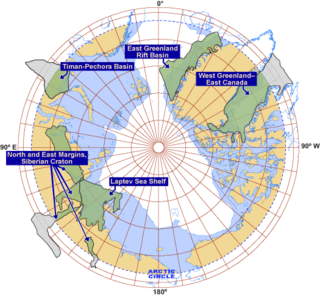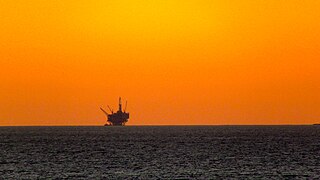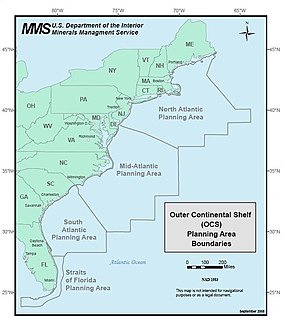
Melville Island is an uninhabited island of the Arctic Archipelago with an area of 42,149 km2 (16,274 sq mi). It is the 33rd largest island in the world and Canada's eighth largest island.

Hibernia is an oil field in the North Atlantic Ocean, approximately 315 kilometres (196 mi) east-southeast of St. John's, Newfoundland, Canada, in 80 m of water.

MV Arctic was an icebreaking cargo ship built in 1978 at the Port Weller Dry Docks in St. Catharines, Ontario, Canada. The ship was owned and operated by the Fednav Group. Arctic was sold for recycling in Aliağa, Turkey in April 2021.

Cameron Island is one of the Canadian arctic islands in Nunavut, Canada. Located in the Arctic Ocean, close to Bathurst Island, it has an area of 1,059 km2 (409 sq mi), 42 to 43 kilometres long and 47 to 38 kilometres wide. Île Vanier lies immediately to the south, across the Arnott Strait.
Oil India Limited (OIL) is the second largest Indian-government owned hydrocarbon exploration and production corporation. The Ministry of Petroleum and Natural Gas oversees its operations, with its headquarters in Duliajan, Assam. The government corporation is a Navratna with its offices in Noida, Uttar Pradesh, Guwahati and Jodhpur.

Petroleum production in Canada is a major industry which is important to the economy of North America. Canada has the third largest oil reserves in the world and is the world's fourth largest oil producer and fourth largest oil exporter. In 2019 it produced an average of 750,000 cubic metres per day (4.7 Mbbl/d) of crude oil and equivalent. Of that amount, 64% was upgraded and non-upgraded bitumen from oil sands, and the remainder light crude oil, heavy crude oil and natural-gas condensate. Most of Canadian petroleum production is exported, approximately 600,000 cubic metres per day (3.8 Mbbl/d) in 2019, with 98% of the exports going to the United States. Canada is by far the largest single source of oil imports to the United States, providing 43% of US crude oil imports in 2015.

APA Corporation is the holding company for Apache Corporation, an American company engaged in hydrocarbon exploration. It is organized in Delaware and headquartered in Houston. The company is ranked 595th on the Fortune 500.

The Canadian petroleum industry arose in parallel with that of the United States. Because of Canada's unique geography, geology, resources and patterns of settlement, however, it developed in different ways. The evolution of the petroleum sector has been a key factor in the history of Canada, and helps illustrate how the country became quite distinct from her neighbour to the south.

The exploration of the Arctic for petroleum is considered to be quite technically challenging. However, recent technological developments, as well as relatively high oil prices, have allowed for exploration. As a result, the region has received significant interest from the petroleum industry.

Offshore drilling is a mechanical process where a wellbore is drilled below the seabed. It is typically carried out in order to explore for and subsequently extract petroleum that lies in rock formations beneath the seabed. Most commonly, the term is used to describe drilling activities on the continental shelf, though the term can also be applied to drilling in lakes, inshore waters and inland seas.

Canada's early petroleum discoveries took place near population centres or along lines of penetration into the frontier.
Offshore oil and gas in the United States provides a large portion of the nation’s oil and gas supply. Large oil and gas reservoirs are found under the sea offshore from Louisiana, Texas, California, and Alaska. Environmental concerns have prevented or restricted offshore drilling in some areas, and the issue has been hotly debated at the local and national levels.

Offshore drilling for oil and gas on the Atlantic coast of the United States took place from 1947 to the early 1980s. Oil companies drilled five wells in Atlantic Florida state waters and 51 exploratory wells on federal leases on the outer continental shelf of the Atlantic coast. None of the wells were completed as producing wells. All the leases have now reverted to the government.
Offshore oil and gas in the Gulf of Mexico is a major source of oil and natural gas in the United States. The western and central Gulf of Mexico, which includes offshore Texas, Louisiana, Mississippi, and Alabama, is one of the major petroleum-producing areas of the United States. Oil production from US federal waters in the Gulf of Mexico reached an all-time annual high of 1.65 million barrels per day in 2017. Oil production is expected to continue the upward trend in 2018 and 2019, based on ten new oil fields which are planned to start production in those years. According to the Energy Information Administration, "Gulf of Mexico federal offshore oil production accounts for 17% of total U.S. crude oil production and federal offshore natural gas production in the Gulf accounts for 5% of total U.S. dry production."

The Melville Island oil sands are a large deposit of oil sands on Melville Island in the Canadian Arctic Archipelago.

Vladimir Ignatyuk is a Russian icebreaking anchor handling tug supply vessel. She was built by Burrard-Yarrows Corporation in Canada in 1983 as Kalvik as part of an Arctic drilling system developed by BeauDril, the drilling subsidiary of Gulf Canada Resources. After the offshore oil exploration in the Beaufort Sea ended in the early 1990s, she was sold to the Canadian shipping company Fednav in 1997 and renamed Arctic Kalvik. In 2003, she was purchased by Murmansk Shipping Company and transferred to Russia.

The Absheron gas field is an offshore natural gas field in the Caspian Sea. The field is located 100 kilometres (62 mi) southeast of Baku and 25 kilometres (16 mi) northeast of the Shah Deniz gas field. It covers approximately 270 square kilometres (100 sq mi).
Miscaroo was an icebreaking anchor handling tug supply vessel built by Vancouver Shipyards for BeauDril, the drilling subsidiary of Gulf Canada Resources, in 1983. She was part of a fleet of Canadian icebreakers used to support offshore oil exploration in the Beaufort Sea. In the 1990s, the vessel was acquired by Canadian Marine Drilling (Canmar) and renamed Canmar Miscaroo. In 1998, she was purchased by Smit International and served in the Sakhalin oil fields as Smit Sakhalin until 2017 when the 34-year-old icebreaker was sold for scrapping in China.
Ikaluk is an icebreaking anchor handling tug supply vessel built by Nippon Kōkan K. K. Tsurumi Shipyard in Japan for BeauDril, the drilling subsidiary of Gulf Canada Resources, in 1983. She was part of a fleet of Canadian icebreakers used to support offshore oil exploration in the Beaufort Sea. In the 1990s, the vessel was acquired by Canadian Marine Drilling (Canmar) and renamed Canmar Ikaluk. In 1998, she was purchased by Smit International and served in the Sakhalin oil fields as Smit Sibu. Since 2009, she was owned by FEMCO Management and in 2012 was given back her original name. Ikaluk was sold to China in February 2018 and later renamed Beijing Ocean Leader.
The Zama Oil Field is an oil field located 60 km off the coast of Tabasco, Mexico, in the Block 7 of the Sureste Basin. It was discovered in July 2017 by Zama-1 well. It’s estimated to hold up to two billion barrels of oil. Zama is named after the Maya word for "dawn".











